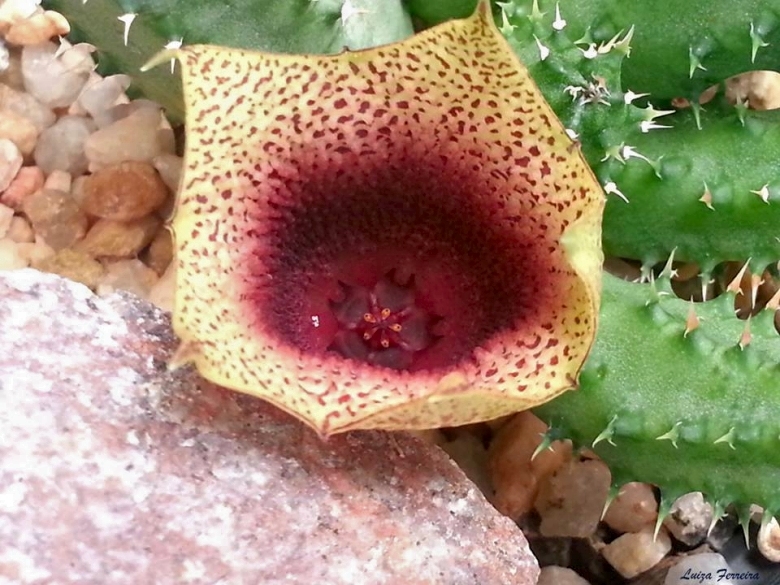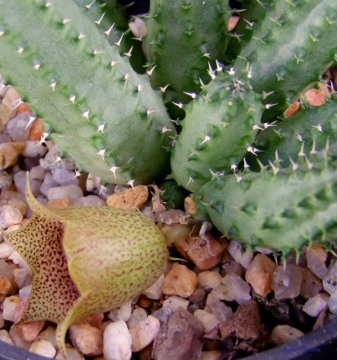Accepted Scientific Name: х Staparesia meintjesii (R.A.Dyer) G.D.Rowley
Natl. Cact. Succ. J. 37(3): 79 (1982)

Tavaresia meintjesii (х Staparesia meintjesii) Photo by: Luiza Ferreira
Origin and Habitat: Nwanedze River, 65 km east of Messina, Transvaal, Republic of South Africa.
Synonyms:
Description: x Staparesia meintjesiiSN|30712]]SN|30712]] (formerly known as Tavaresia meintjesiiSN|25062]]SN|30713]]) is an exceptional beautiful Stapeliad with very pretty markings on this flower, etched in maroon. Leach suggests that it is possibly a natural hybrid between Stapelia gettliffei R. Pott (or Stapelia giganteaSN|19218]]SN|19218]] N.E.Br.) and Tavaresia barklyiSN|25061]]SN|25061]] (Dyer) N.E. Br. (syn. Tavaresia grandifloraSN|30713]]SN|25062]]). This cross has also been successfully repeated in cultivation either with Stapelia gettlifei and Stapelia gigantea. Leach says that there are 2 flower colours seen in such hybrids. One with a lighter colour (hybrid with Stapelia giganteaSN|19218]]SN|19218]]) and one with a darker colour (hybrid with Stapelia gettlifei). Both this hybrids should be named Staparesia meintjesiiSN|30712]]SN|30712]].
Bibliography: Major references and further lectures
1) Colin C. Walker “× Tavarorbea: another intergeneric hybrid stapeliad” Dept. of Biological Sciences, Open University, Milton Keynes, MK7 6AA, England. Asklepios Tavarorbea 22.10.2004
2) Albers, F. & Meve, U. (eds.) “Illustrated Handbook of Succulent Plants – Asclepiadaceae.” Springer, Berlin, etc.2002
3) Rowley, G.D. “Intergeneric hybrids in Asclepiadaceae tribe Ceropegieae.”
Asklepios, 89: 8–12.(2003)
 Tavaresia meintjesii (х Staparesia meintjesii) Photo by: Luiza Ferreira
Tavaresia meintjesii (х Staparesia meintjesii) Photo by: Luiza Ferreira Tavaresia meintjesii (х Staparesia meintjesii) Photo by: Luiza Ferreira
Tavaresia meintjesii (х Staparesia meintjesii) Photo by: Luiza FerreiraCultivation and Propagation: x Staparesia meintjesiiSN|30712]]SN|30712]] grows robustly and is far less temperamental than Stapelia is in cultivation, and hence is more akin to Stapelia giganteaSN|19218]]SN|19218]], which is amongst the most resilient stapeliads in captivity. S. meintjesii is a worthy addition to cultivation and deserves to be widely grown and appreciated, since it makes an ideal hanging-pot plant, in which the flowers dangle over the pot edge.
Soil: They grow well in light gritty soil with a very liberal drainage.
Watering: They should at all times sparingly watered (best rain water with some occasional fertiliser), and in winter time they hardly require any.
Temperature: They require outdoor culture, or a warm close greenhouse, while growing in the early part of summer, and afterwards may be ripened and kept in a greenhouse; but as they bloom chiefly in autumn, warmth is desirable to enable them to expand their flowers. A minimum winter temperature of 5-10°C is acceptable, providing that plants are kept absolutely dry.
Exposure: They prefer light shade rather than full sun, although stems may not colour up under shady conditions.
Pest & diseases: Keep their roots free of mealy bugs, as fungal attack often occurs as a result of damage to stems by insects. A layer of grit on the surface of the compost prevents moisture from accumulating around the base of the stems and minimise the chance of fungal attack on the roots.
Propagation: Plants are increased by cuttings, which, as they are very succulent, should be allowed to dry a week after they are taken off, when they may at once be put singly into pots.













